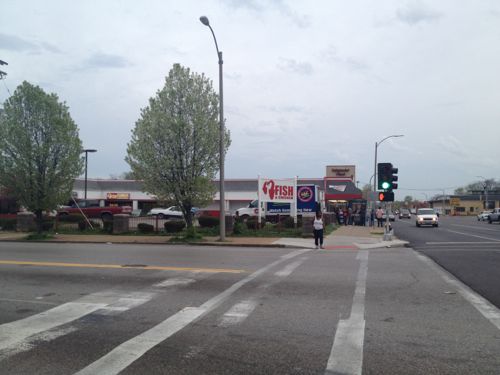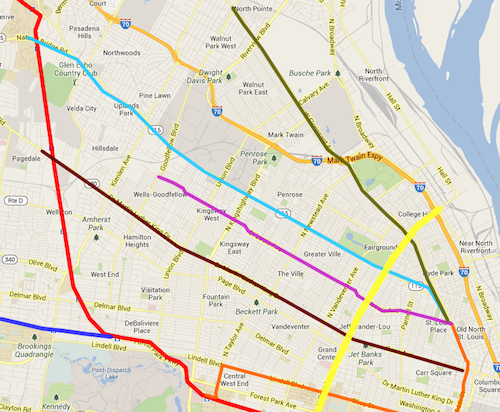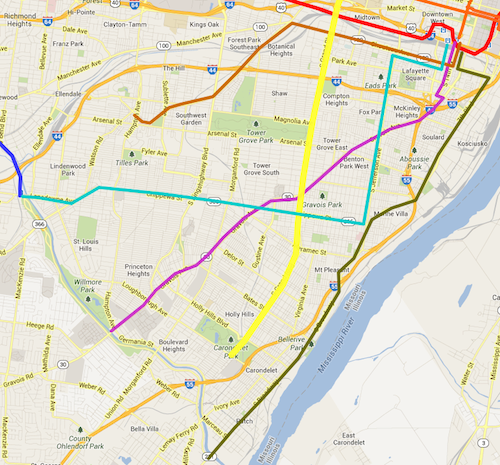Readers Lean Toward Expanding Proposed Modern Streetcar Line With Connections To MetroLink Light Rail
The poll last week had two related questions, basically how you’d expand the proposed streetcar through north & south city, respectively.
North:
Poll #1/2: From the options below, select how you’d extend the proposed streetcar line further into north city from N. Florissant & St. Louis Ave:
- N. Florissant>Natural Bridge>UMSL South MetroLink Station 14 [26.42%]
- None, I’d prefer light rail over modern streetcar 8 [15.09%]
- None of the above, don’t extend at all 7 [13.21%]
- Better to expand north from Lindell @ Taylor 7 [13.21%]
- Cass>MLK/St. Charles Rock Rd>St. Charles Rock Rd MetroLink Station 4 [7.55%]
- Unsure/No Answer 4 [7.55%]
- None, I’d take a route not listed 3 [5.66%]
- Won’t be anything to extend 3 [5.66%]
- St. Louis Ave>Goodfellow 2 [3.77%]
- N. Florissant>Goodfellow 1 [1.89%]
The option that was, at least partially, selected for a north extension of our light rail received the highest number of votes, though hardly a consensus. In that plan the light rail turned north at Goodfellow, whereas I proposed continuing west to UMSL. This would be about a 7 mile extension, perhaps built in 1-3 phases. Natural Bridge is excessively wide so the streetcar could run in a median, just as was planned with the light rail. Nearly the entire route is suitable for densification without displacement. This could bring much needed jobs as well as new housing options.

This alignment would replace the current #4 (Natural Bridge) MetroBus route. Current frequencies range from 27 minutes to one hour, depending upon the time of day.

UMSL is working on a plan to improve Natural Bridge, better connecting to the UMSL South MetroLink light rail station. A modern streetcar could be a great connection, helping deal with that first/last mile to/from light rail.
South:
Poll #2/2: From the options below, select how you’d extend the proposed streetcar line into south city from 14th & Spruce:
- 14th/Spruce> Chouteau> Jefferson> Chippewa> Lansdowne> Shrewsbury MetroLink Station 15 [28.3%]
- 14th/Spruce> Lafayette> Tucker> Gravois> Hampton 13 [24.53%]
- 14th/Spruce> Chouteau> Vandeventer> Southwest> Hampton 7 [13.21%]
- None, I’d prefer light rail over modern streetcar 5 [9.43%]
- 14th/Spruce> Chouteau> Broadway > River Des Peres 3 [5.66%]
- Other: 3 [5.66%]
- None, I’d take a route not listed 2 [3.77%]
- Won’t be anything to extend 2 [3.77%]
- Better to expand south from Forest Park @ Taylor 2 [3.77%]
- None of these, don’t extend at all 1 [1.89%]
- Unsure/No Answer 0 [0%]
Three readers provided their owner answers to this question:
- I’d like to see the route follow Jefferson, but continue south on Broadway
- 14th/Spruce>Gravois>Jefferson
- think about the goals of the whole system first
Like The goals for a streetcar go beyond just transit, they include:
- Creating dense corridors.
- Spurring new construction, creating construction & permanent jobs.
Looking at the votes here it looks like readers would prefer the south alignment to get into the heart of the southside rather than stay closet to Broadway/I-55. If we were to build the planned light rail instead it would go down Jefferson to Broadway and terminate in a park- & ride lot at I-55, with further expansion along the I-55 ROW into South County.

The south streetcar alignment that received the most votes would replace the current #11 (Chippewa) MetroBus which does a big “L” by traveling on Jefferson (north-south) and Chippewa (east-west). This would intersect with many existing bus routes, including the very busy #70 (Grand).
Right behind in votes was an alignment that would replace the rest of the #10 (Gravois-Lindell) MetroBus. Part of this bus route would be replaced by the original streetcar route on Olive/Lindell. Going down Gravois would cut through a big section of south city, connecting with east-west & north-south buses.
Thoughts?
— Steve Patterson
From a transit planning perspective, it would depend on a cost-benefit analysis – where does it make the most sense to spend the money (that we currently don’t have). From a “selfish”, personal perspective, run it between where I (want to) live and where I work – improve MY commute. And from a development / job creation / urbanism standpoint, build it to enhance already-successful areas – running it through substantially-vacant areas will do little to encourage denser, urban development.
Flawed logic. New jobs won’t be created in successful/built out areas, they’ll be created in developers build new buildings to suit companies on areas that are currently vacant. Modern streetcars do best if they have points with existing users and points for future development, having only one without the other is a recipe for failure.
Flawed logic. “Future development” seems to be doing just fine in the St. Louis region with little or no access to public transit. The two biggest retail / job-creating projects currently under way in the area are the two outlet malls in Chesterfield. Neither one has a streetcar, and both will succeed without streetcars, although both will probably get bus service, thanks to John Nations. Transit, be it bus, streetcar or gondola, only serves to incentivize development IF people choose (or are forced, due to cost or congestion) to use transit. You seem to think that way more people will ride a streetcar than currently ride the bus – I disagree. The three best ways to get people to choose transit are to make it cheap / free, make it frequent and have it go where people need to / want to go. And the best way to that is buses – many, many buses – they’re cheaper to deploy than streetcars, they’re able to easily adjust to changes in employment patterns and they “play” way better in urban traffic than vehicles on fixed, steel rails do!
Thank You!!! Exactly JZ…spending hundreds of millions on streetcars just so we can recreate a shell of the glory days does not make sense. I, as a taxpayer, would be more willing to take that $100 + million and give everyone free bus service for a year (with the caveat that the busses have to be spotless and cheerful drivers) in the hopes that we can convince enough people that hey, bus service isn’t just for “those” people. Then everything else will follow.
How would everyone getting free bus service foe a year create new construction? Job? What happens after that year?
what do you want: short term construction jobs or overall more people using public transportation (that hopefully will continue after the free period).
“The common held elasticity of transit fares is -0.3, meaning that for every 10% drop in fares we would expect a 3% increase in ridership (this is usually referred to in the context of a fare hike, where a 10% increase in fares would equate to a 3% decrease in ridership). So, a 100% decrease in fares would equate to a 30% increase in ridership under this model. Three major cities in the United States have attempted widespread free fare experiments in the past thirty years – Denver; Trenton, NJ; and Austin. In Denver, ridership increased 36% while it increased 16% in Trenton. In both Denver and Trenton, the free fare was only in effect during off-peak periods. In Austin, ridership increased 75% but when discounting normal growth and University of Texas students, the ridership increase may have been as little as 10%.” Source: http://publictransport.about.com/od/Transit_Funding/a/What-Would-Happen-If-Transit-Were-Free.htm
Yes, building a streetcar line will create new construction jobs while the line is being built (with taxpayer dollars). However, there are no guarantees that private investment will follow the addition of either a streetcar line or a bus line. I’ll repeat, streetcars are one type of public transit, used by some, but not all, people, to get around. Streetcars are not magic unicorns, whose very presence will cause dense urban buildings to spring from barren earth. While streetcars can help sway a buyer’s or lessor’s decision, so can many, many other factors – free parking, rental rates, proximity to customers, building amenities, “green” features, history/patina, tax rates, crime (both perception and reality), where the boss lives, racism, dining options, workout options, views, availability / how quickly space can be occupied, biking options, architectural style preferences, floorplate sizes, traffic counts, demographics, contamination, utility costs, etc, etc, etc.
Well a standard bus line is guaranteed to not impact development, modern streetcar lines combined with a taxing district and form-based codes have been proven to work.
A taxing district? there is a beginning backlash at all these taxing districts to pay for everyone’s pet projects…that is just going to make it more expensive (and another hurdle) for any retailer to overcome.
As for free fares…what you’re saying is that free fares have indeed boosted ridership. A whooping 800% in Belgium (which you chose to look over)…and interesting that the green cities…Chapel Hill and Summit County are offering free service. Chapel Hill has a population of near 60,000….and Summit County offers it free because they realize the need for workers to get to work as well as during peak season to avoid too many cars/pollution. Austin only did it in off peak hours and it increased…what if they had done it during peak hours as well????
Besides that the article was opinion over facts…..the bottom glaring opinion offered against was…heaven forbid…”undesirables” using the bus system.
Properties that don’t offer free fares at peak times do so due to capacity constraints – the buses are already full, while they have excess capacity during off-peak times. Metro used to offer a free-fare zone downtown on Metrolink. It worked, but in their infinite wisdom, it was eliminated, under the assumption that a few people would actually pay $2.25 to go two or three stops – “win the battle, lose the war”?!
To JZ: Sort of like the South County Connector plan. Great for those with a personal interest – either shifting traffic off of their residential street (the grid) or maybe shortening commute times for South County/Jeff Co commuters. But opposed by planners and community organizations such as the Maplewood City Council, the Maplewood Chamber of Commerce, the St. Louis Board of Aldermen, and Trailnet. I really hope they release the public comments on the SCC. Has there been even *one* community organization come out in favor of the South County Connector? Even one?
Shrewsbury?
If that’s the case, it’s for purely selfish reasons: to divert traffic off of their streets. If it’s their problem, then let them pay for it. They TIF a Walmart to suck retail dollars into Shrewbury from surrounding areas. Now they want the County, the State of Missouri, and the Feds to spend $110,000,000 plus to calm traffic for Shrewsbury residents, while concentrating commute traffic onto a City of St. Louis street and taking City of St. Louis parkland. It’s really the height of arrogance.
Agree completely, and I’ve been saying that in my written comments every time they’ve had a public meeting on the project! If they want to solve “the problem”, the road needs to go through McKenzie Pointe Shopping Center, to directly connect McKenzie on the south with Hanley on the north and provide a straight shot between the heart of south COUNTY and Clayton. Using RDP, a CITY street, to solve a COUNTY “problem” IS truly the height of arrogance!
Going back 60 years, there was talk of expanding Elm in Webster Groves for the north/south connector. We know as that is one of the reasons we chose not to live on Elm back then. Then it was reviewed again during the 40/64 reconstruct. But oh no, NIMBY.
Who wants to live next to a main arterial road? Who wants to live next to the South County Connector? Why are homes more desirable further away from main roads rather than right next to them?
Dont forget that Shrewsbury has done more than its share of handling traffic. Interstate
44 goes right through it, and a widened Laclede Station road also does.
Seriously?? You want to talk about cities “doing their share to handle traffic” with interstates going right through them? NONE can match the damage the City of St. Louis has suffered at the hands of highway builders. Shrewsbury? Pfffft.
The best way to improve transit in south st Louis is to build a light rail extension along the Union Pacific
route from downtown southwest to the Hill and then southeast to Carondolet Park and then into South
County. This was the route on transit plans until several years ago when East West deleted it and substituted
a route along Jefferson. In effect, this replaced a rapid light rail for a slow streetcar. The change was partly
made for transit fads such as transit-oriented development and because Union Pacific insisted on a very
wide seperation of tracks. This is the only real practical route for light rail extension other than a route from
Clayton to Westport. Transit planners, however, seem to have given up on light rail extensions
The SCC has NOTHING to do with “transit in south St. Louis”, it has everything to do with connecting Oakville, Mehlville and Lemay with Clayton, which means figuring out how to create a corridor in cities in between. That said, Union Pacific owns their line / corridor. They apparently have no interest in selling. The ONLY way for Metro can gain control would be through condemnation, much like how the only way a logical corridor could be created through Shrewsbury and the McKenzie Pointe shopping center would be through condemnation.